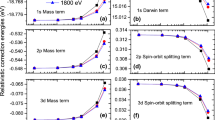Abstract
This work describes a simple thermodynamic model of the hydrogen gas at low densities and for temperatures going from those involving quantum rotations of ortho- and para-hydrogen up to the fully ionized state. The closed-form energy levels of Morse rotating oscillator given [D.C. Harris, M.D. Bertolucci, Symmetry and Spectroscopy (Dover, New York, 1989)] (but not those in Morse’s original paper) are shown to provide an internal partition function of H2 that is a sufficiently accurate representation of that exploiting the state-of-the-art spectrum of roto-vibrational levels calculated by Pachucki and Komasa [K. Pachucki, J. Komasa, J. Chem. Phys. 130, 164113 (2009)]. A system of two coupled quadratic equations for molecular dissociation and atomic ionization at thermodynamical and chemical equilibrium is derived according to the statistical mechanics by assuming that the system is an ideal mixture containing molecules, neutral atoms and noninteracting protons and electrons. The system of two equations reduces to a single quartic equation for the ionization unknown, with the coefficients dependent on the temperature and the specific volume. Explicit relations for specific energy and entropy of the hydrogen ideal gas/plasma model are derived. These fully compatible equations of state provide a complete thermodynamic description of the system, uniformly valid from low temperatures up to a fully ionized state, with electrons and ions relaxed to one and the same temperature. The comparison with results of other models developed in the framework of the physical and chemical pictures shows that the proposed elementary model is adequate for computational fluid dynamics purposes, in applications with the hydrogen gas under diluted conditions and when the dissociation and ionization can be assumed at thermodynamical and chemical equilibrium.
Graphical abstract

Similar content being viewed by others
References
H.B. Callen, Thermodynamics and an Introduction to Thermostatistics (John Wiley & Sons, New York, 1988)
R. Kubo, Statistical Mechanics (North-Holland Publishing Company, Amsterdam, 1965)
J. Lighthill, J. Fluid Mech. 2, 1 (1957)
W.G. Vincenti, C.H. Kruger, Introduction to Physical Gas Dynamics (John Wiley, New York, 1965)
P.M. Morse, Phys. Rev. 34, 57 (1929)
F.J. Gordillo-Vázquez, J.A. Kunc, J. Appl. Phys. 84, 4693 (1998)
L.D. Landau, E.M. Lifshitz, Statistical Physics (Elsevier, Oxford, 1980), Part. 1
D.G. Hummer, D. Mihalas, ApJ 331, 794 (1988)
D. Mihalas, W. Däppen, D.G. Hummer, ApJ 331, 815 (1988)
A. Alastuey, V. Ballenegger, F. Cornu, Ph.A. Martin, J. Stat. Phys. 130, 1119 (2008)
A. Alastuey, V. Ballenegger, Contrib. Plasma Phys. 52, 95 (2012)
Ya.B. Zel’dovich, Yu.P. Raizer, Physics of Shock Waves and High-Temperature Hydrodynamic Phenomena (Academic Press, New York, 1967)
K. Pachucki, J. Komasa, J. Chem. Phys. 130, 164113 (2009)
D.C. Harris, M.D. Bertolucci, Symmetry and Spectroscopy (Dover, New York, 1989)
E. Fermi, Z. Phys. 26, 54 (1924)
Y. Babou, Ph. Rivière, M.-Y. Perrin, A. Soufiani, Int. J. Thermphys. 30, 416 (2009)
G.A. Blake, Lecture # 7 (2009), www.gps.caltech.edu/˜gab/ch21b/lectures/lecture07.pdf,
G.V. Yukhnevich, Dokl. Phys. 45, 201 (2000)
D. Bruno, F. Esposito, V. Giovangigli, J. Chem. Phys. 138, 084302 (2013)
M. Capitelli, G. Colonna, A. D’Angola, Fundamental Aspects of Plasma Chemical Physics, Thermodynamics (Springer, New York, 2011)
J.M.L. Martin, J.P. Francois, R. Gijbels, J. Chem. Phys. 96, 7633 (1992)
G. Emanuel, Advanced Classical Thermodynamics (AIAA Education Series, Washington D.C., 1987)
W. Grimus, arXiv:1112.3748v1 [physics.hist-ph] (2011)
M.R. Zaghloul, Phys. Plasmas 17, 062701 (2010)
A.Y. Potekhin, Phys. Plasmas 17, 124705 (2010)
M.R. Zaghloul, Phys. Plasmas 17, 124706 (2010)
Don Herbison-Evans, Technical Report TR94-487, Basser Department of Computer Science, University of Sydney (2011)
T.L. Hill, Statistical Mechanics, Principles and Selected Applications (Dover, New York, 1987)
R.T. Jacobsen, J.W. Leachman, S.G. Penoncello, E.W. Lemmon, Int. J. Thermophys. 28, 758 (2007)
J.W. Leachman, R.T. Jacobsen, S.G. Penoncello, E.W. Lemmon, J. Phys. Chem. Ref. Data 38, 721 (2009)
R.J. Le Roy, S.G. Chapman, F.R.W. McCourt, J. Phys. Chem. 94, 923 (1990)
A.Y. Poteckhin, Phys. Plasmas 3, 4156 (1996)
M. MacLean, A. Dufrene, T. Wadhams, M. Holden, AIAA 2010-1562, 48th Aerospace Sciences Meeting, Orlando (2010)
Author information
Authors and Affiliations
Corresponding author
Rights and permissions
About this article
Cite this article
Quartapelle, L., Muzzio, A. A simple thermodynamic model of diluted hydrogen gas/plasma for CFD applications. Eur. Phys. J. D 69, 156 (2015). https://doi.org/10.1140/epjd/e2015-60124-6
Received:
Revised:
Published:
DOI: https://doi.org/10.1140/epjd/e2015-60124-6



